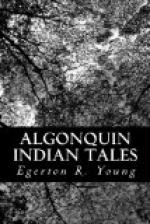“Let us wait until dark,” said Sagastao, “and then Mary won’t see our dirty clothes!” For their greasy fingers had soiled them badly.
The wishes of the little girl, however, prevailed, and so it was not long ere the Indian salutations, “Wat cheer! Wat cheer!” were shouted to all, and once more the two children were hoisted upon the shoulders of the big Indians, and in the same manner in which they had been brought to the wigwam in the forenoon they rode home in the beautiful gloaming.
Very tired were they, yet not so weary but that they were able with their little hands to rub some of the paint off the faces of their big stalwart carriers and daub it on their own. The effect was so ludicrous that their merry laughter reached the ears of their expectant parents even before they emerged from the gloom of the forest.
CHAPTER II.
The Children’s Return—Indignation of Mary, the Indian Nurse—Her Pathetic History—Her Love for the Children—The Story of Wakonda, and of the Origin of Mosquitoes.
In reaching home the children were quietly received by their parents, who, understanding Indian ways, had no desire to lessen their influence by finding fault with them for carrying off the children. They treated the matter as though it were one of everyday occurrence.
Mary, the Indian nurse, however, did not regard the incident so calmly. When the children were brought back dirty, greasy, bedaubed, and so tired that they could hardly hold up their little heads, her indignation knew no bounds, and as she was perfectly fearless she couched her sentiments in the most vigorous phrases of the expressive Cree language.
The history of Indian Mary was very strange. Indeed there was an incident in her life so sad that from the day of her recovery she was considered to be under the special care of the Good Spirit, so that even the most influential chiefs or hunters had a superstitious fear of showing any temper, or making any bitter retort, no matter what she might say.
Years before this time Mary was the wife of a cruel pagan Indian who bore the English name of Robinson. Although she was slight of figure, and never very strong, he exacted from Mary a great deal of hard work and was vexed and angry if, when heavily burdened with the game he had shot, she did not move as rapidly along on the trail as he did, carrying only his gun and ammunition.
Once, when they were out in the woods some miles from his wigwam, he shot a full-grown deer and ordered her to bring it into the camp on her back. Picking up his gun he started on ahead, and being a large, stalwart man, and moving with the usual rapidity of the Indians on the homeward trail, he soon reached his wigwam. Unfortunately for him—and, as it turned out, for Mary also—he found some free-traders[1] at his abode awaiting his return. They had few goods for trade in their outfit, but they had a keg of fire water, which has ever been the scourge of the Indians.




